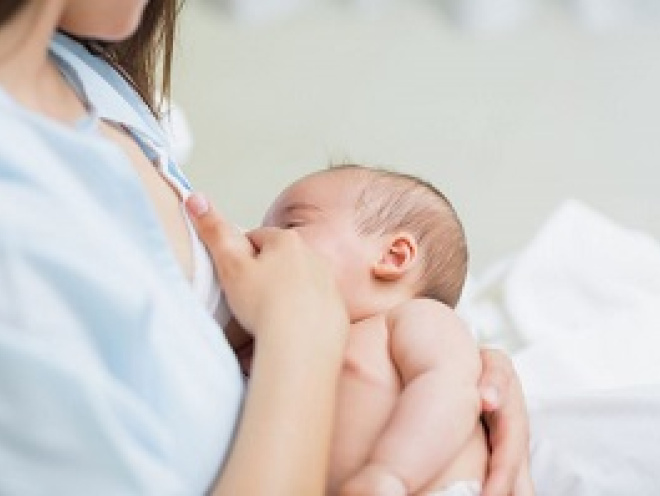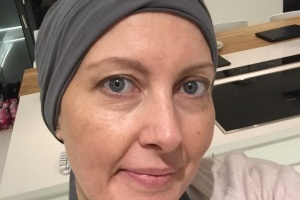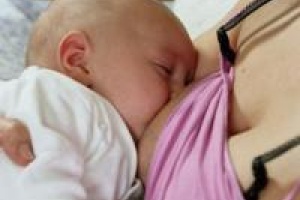If you’ve had breast cancer or are going through treatment for breast cancer, we look at your options for breastfeeding.
Having breast cancer is an incredibly difficult experience for anyone to go through. But what if you want to breastfeed? What impact will breast cancer have on your experience of feeding? Here we look your options and the support available to you.
Can I breastfeed after breast cancer?
Whether you can breastfeed may depend on the treatment you had, or are having, for breast cancer, though research shows that ultimately support is critical to success (Bhurosy et al 2020).
Some women and birthing parents might have difficulties establishing a full breastmilk supply because of their treatment, for instance. However, with the right support, many go onto have a meaningful breastfeeding relationship with their baby.
No matter how much breastmilk you’re able to produce, it’s important to remember that every single drop of breastmilk is beneficial for your baby (American Cancer Society, 2019).
Equally, there are so many ways to feel close and bond with your baby – however you feed them. Your baby will always benefit from – and really love – skin-to-skin contact with you straight from birth. If you bottle-feed your baby, you can take a paced bottle-feeding approach where your relationship develops with your baby and they lead the way with feeding, as they would with breastfeeding.
If you have a birth plan, it can be helpful to mention that you’ve had breast surgery in the past. It will help you get support and understanding through your care. And it should also mean you won’t need to explain any decisions repeatedly to different healthcare professionals, though you may find you have to remind them.
Hormone therapy
Anyone on hormone therapy, such as Tamoxifen, is advised not to breastfeed while on this medication as it could be harmful to their baby (Breast Cancer Now, 2018). Tamoxifen can also reduce milk supply (Hale, 2020).
Some women and birthing parents might offer initial feeds of colostrum (the first milk your breasts produce) for a day or two before resuming hormone therapy. For those whose overall risk of breast cancer is lower, a break of a few months might be a possibility (Breast Cancer Now, 2018).
You can discuss your options with a relevant healthcare specialist to decide on the most appropriate length of time for a break from therapy (Breast Cancer Now, 2018).
Lumpectomy and radiotherapy
Women and birthing parents often find that if they’ve had a wide local excision, also known as a lumpectomy, the affected breast may not produce much milk. This is particularly true if the lump was removed close to the nipple. It’s likely that more of the ducts that carry the milk within the breast and nerves may have been damaged by the surgery. Radiotherapy is likely to further affect the breast’s ability to make milk (Drugs and Lactation database, 2020).
Breastfeeding from one breast is a possibility though, as it is likely that with support, you'll establish a full milk supply from the breast that didn’t have the radiation treatment (Macmillan Cancer Support, 2017a).
If your baby needs to receive supplements, some people find it helpful to use an at-breast supplementer, also called a supplemental nursing system (see below), either with donor breastmilk or formula milk (Macmillan Cancer Support, 2017b).
Mastectomy
After mastectomy, if there has been reconstructive surgery on the breast and nipple, it may be possible to feed your baby at your breast using a supplemental nursing system. The system can contain donated milk or formula milk.
A supplemental nursing system is basically a container of milk attached to a piece of flexible feeding tube. The free end of the tube is held or taped to run alongside your nipple so that your baby can take the tube and nipple together in their mouth (Pearson-Glaze, 2018). You can read more about breastfeeding with a supplemental nursing system here.
Although these devices can be a little fiddly to clean and set up, some women and birthing parents who have tried feeding their baby this way say they find being able to put their baby to their breast can be emotionally comforting.
Nipple tattoos
Some women and parents might choose to have a nipple tattooed onto their reconstructed breast rather than using tissue to re-build a nipple (Breastcancer.org, 2019). Whilst 3D nipple tattoos look very lifelike, they do not create an actual nipple for your baby to latch on to.
It may help to use a nipple shield to create something the baby can take into its mouth with the supplemental nursing system. It is always a good idea to seek the support of a qualified Breastfeeding Counsellor or IBCLC for complex breastfeeding challenges like this.
Breast balancing surgery
Sometimes women and parents have surgery to match the size and shape of their reconstructed breast to their other breast (Macmillan Cancer Support, 2017b). This type of balancing surgery might affect the milk supply produced from that breast. It’s worth talking to your surgical team, clinical nurse specialist or breast-care nurse about this.
Support if you need it
Before birth, it’s worth letting your midwife or the local infant feeding team know that extra support and information would be appreciated if you have had any breast surgery.
You could also call one of our Breastfeeding Counsellors to talk through any of the issues discussed in this article on 0300 330 0700 (open between 8am and midnight every day).
This page was last reviewed in April 2021.
Further information
NCT supports all parents, however they feed their baby. If you have questions, concerns or need support, you can speak to a breastfeeding counsellor by calling our helpline on 0300 330 0700, whether you are exclusively breastfeeding or using formula milk. Our breastfeeding counsellors have had extensive training, will listen without judging or criticising and will offer relevant information and suggestions. You can also find more useful articles here.
Breastfeeding after cancer treatment from Macmillan Cancer Support
Information and support with pregnancy after breast cancer
After Breast Cancer Diagnosis - supporting primary and secondary breast cancer patients to make informed decisions with information and up to date news on treatments, breast surgeries, consultants, hospital and useful links.
Breast reconstruction leaflet from Breast Cancer Care
American Cancer Society. (2019) Pregnancy After Breast Cancer. Available from: https://www.cancer.org/cancer/breast-cancer/living-as-a-breast-cancer-survivor/pregnancy-after-breast-cancer.html [Accessed April 2021]
Azim HA Jr, Santoro L, Pavlidis N, Gelber S, Kroman N, Azim H, Peccatori FA. (2011) Safety of pregnancy following breast cancer diagnosis: a meta-analysis of 14 studies, European Journal of Cancer. 47(1):74-83. Available from: https://www.ncbi.nlm.nih.gov/pubmed/20943370 [Accessed April 2021]
Breast Cancer Now. (2018) Tamoxifen. Available from: https://breastcancernow.org/information-support/facing-breast-cancer/going-through-treatment-breast-cancer/hormone-therapy/tamoxifen [Accessed April 2021]
NHS. (2016) Breast Cancer in Women. Available from: https://www.nhs.uk/conditions/breast-cancer/causes/ [Accessed April 2021]
M. Hickey, M. Peate, C.M. Saunders, M. Friedlander, Breast cancer in young women and its impact on reproductive function. (2009) Human Reproduction Update. 15(3):323–339. Available from: https://doi.org/10.1093/humupd/dmn064
Macmillan Cancer Support. (2017a) Breastfeeding After Treatment . Available from: https://www.macmillan.org.uk/information-and-support/audience/cancer-and-pregnancy/breastfeeding.html [Accessed April 2021]
Macmillan Cancer Support. (2017b) Surgery to the other breast. Available from: https://www.macmillan.org.uk/information-and-support/treating/surgery/types-of-breast-reconstruction/surgery-to-the-other-breast.html [Accessed April 2021]
Marilyn L. Kwan, Philip S. Bernard, Candyce H. Kroenke, Rachel E. Factor, Laurel A. Habel, Erin K, Weltzien, Adrienne Castillo, Erica P, Gunderson, Kaylynn S, Maxfield, Inge J, Stijleman, Bryan M, Langholz, Charles P, Quesenberry, Lawrence H, Kushi, Carol Sweeney, Bette J Caan. (2015) Breastfeeding, PAM50 Tumor Subtype, and Breast Cancer Prognosis and Survival. JNCI: Journal of the National Cancer Institute. 107(7). Available from: https://doi.org/10.1093/jnci/djv087 [Accessed April 2021]
Pearson-Glaze, Philippa. (2018) Breastfeeding With a Supplemental Nursing System. Available from: https://breastfeeding.support/supplemental-nursing-system/ [Accessed April 2021]
Schnitt S, Connolly J, Harris JR, Cohen RB. (1984) Radiation-induced changes in the breast, Human Pathology. 15(6):545-550. Available from: https://doi.org/10.1016/S0046-8177(84)80008-8. [Accessed April 2021]
3D Nipple Tattoos. (2019) Breastcancer.org. Available from: https://www.breastcancer.org/treatment/surgery/reconstruction/types/nipple/3d-nipple-tattoo [Accessed April 2021]
Hale TW (2020) Medications and Mother Milk: A Manual of Lactational Pharmocology, Springer Publishing Company
Further sources of support
You might find this support website with more information about 3D nipple tattooing helpful:
https://www.breastcancerhaven.org.uk/blog/3d-nipple-tattooing
Further references
This study looks into whether breastfeeding is feasible after breast cancer treatment, and concludes that support is key:
Bhurosy T, Niu Z, Heckman CJ. Breastfeeding is Possible: A Systematic Review on the Feasibility and Challenges of Breastfeeding Among Breast Cancer Survivors of Reproductive Age. Ann Surg Oncol. 2020 Sep 11:10.1245/s10434-020-09094-1. doi: 10.1245/s10434-020-09094-1. Epub ahead of print. PMID: 32915334; PMCID: PMC7947020.
This literature review serves as a comprehensive resource of evidence-based recommendations for managing lactation in breast cancer survivors and breastfeeding women with a new breast cancer diagnosis:
Johnson HM, Mitchell KB. Breastfeeding and Breast Cancer: Managing Lactation in Survivors and Women with a New Diagnosis. Ann Surg Oncol. 2019 Oct;26(10):3032-3039. doi: 10.1245/s10434-019-07596-1. Epub 2019 Jul 24. PMID: 31342385.
Drugs and Lactation Database (LactMed) [Internet]. Bethesda (MD): National Library of Medicine (US); 2006-. Radiotherapy. [Updated 2020 Dec 21]. Available from: https://www.ncbi.nlm.nih.gov/books/NBK501723/








